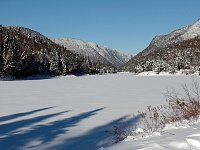
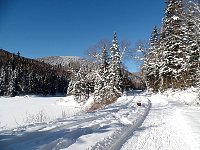
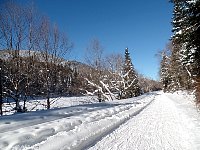
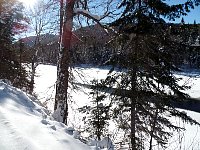
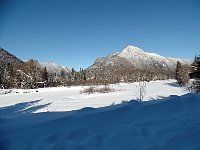
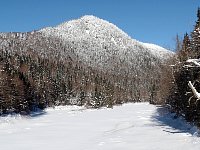
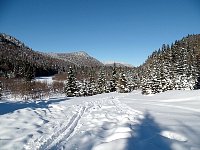
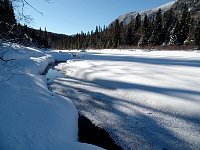
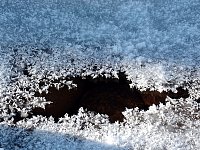
Going to Canada for three days.
That's not quite the worst travel-time to being-there ratio I had on a trip (for that, I'll probably never beat going to Zambia for a day to see a solar eclipse). But it's still a long way to go for such a short vacation.
It was also a bit of a 'leftover' trip with activities that didn't work out in 2012.
Back then, I was dog sledding in the Yukon and at the end of the vacation I wanted to go to Quebec City and stay in the ice hotel there.
I booked a room there and I did go to Quebec City, but unfortunately it was a warm winter. I arrived in the last week in which the ice hotel was (supposed to be) open. As the outside temperatures were at a +15°C, the hotel started melting and they closed it a week earlier than planned. So they cancelled my reservation and I didn't get to stay there in 2012.
Then I went to Montréal in December 2012. Too early to add a short side trip to ice hotel (it opens in early January each year), but there was another activity that looked interesting - ice canyoning.
But it wasn't quite cold enough for that, so I didn't get to do that either. (And went to Algonquin Park instead.)
So I didn't go to the ice hotel and I didn't do ice canyoning in 2012.
Naturally, it seemed like a good idea to go to Canada to do that!
Scheduling turned out to be a bit tricky, so instead having a big vacation in Canada and just spending a part of it in Quebec, in the end it just turned into a mini-vacation.
(Probably a suspiciously short vacation, as I was singled out at immigrations/customs for extra questioning/searching. That might just been random, but it's also likely that someone who flies from Europe to Canada for a three day vacation (as opposed to a business trip) triggers some sort of 'better check that guy out' warning at the border. But as I really was on a vacation (and had all the bookings and reservations to show it), there weren't any problems.)
On the first day, I did a little bit of walking in the "Jacques-Cartier National Park", about 50 km north of Quebec.
I went to the information center, asked about hikes and they recommended a nice loop called "Les Coulées".
It started on a path along the Jacques-Cartier River and then continued along the smaller Sautauriski brook.
After that, the path went up a hill to a sightseeing spot.
It was a pleasant day to spend outdoors - temperatures around -18°C, lots of sunshine, a good trail to walk on and I had the park mostly to myself.
The drive to and from the information center was a good refresher on winter driving.
The center is 10 km into the park and the park road was good, but covered with packed snow, so it required some careful driving (and resisting the temptation to drift around the corners).
The rented car had a rather pointless feature.
A little light on the dashboard that lit up when you were skidding.
Technically, it was the 'Traction Control System Light'. But instead of letting you know when the wheels have less traction than expected (which might be a useful warning that the road is kind of slippery), it only came on when you (essentially) had lost already traction.
Which is something you tend to notice anyway.
What it tries to tell you is that the car is trying not spinning the wheels needlessly. But that is basically just bragging 'look, this car has a traction control system'. I assume that the car will also not send more fuel to the engine than the engine needs, but I don't see it flashing a little 'fuel control active' light. And while the car had automatic transition, it didn't proudly show me a 'changing gear' light every time it did so.
And, similarly, the 'Traction Control System' should just do its job be quiet about it.
Since, in effect, it is really distracting when you need not to be distracted.
When you're on the road (or in a parking place) and the car spins a bit, you need your full concentration on making it stop spinning before you hit anything, so turning on a light on the dashboard that cries for your attention and makes you look away from the road is stupid.
(It's not like anything bad happened. I didn't crash into something or even just got off the road. But it's annoyingly bad user interface design.)
Realistically, the only use for the 'skid light' is to try to see how long you can keep it on continuously when driving on slippery roads.
And I assume that does kind of encourages risky driving...
But back to Quebec.
In the late afternoon, I checked in for the ice hotel.
The have different types of rooms there. Normal rooms (at least as far as staying in a hotel out of ice is normal) and theme suites. The theme suites come in three categories: Standard; Premium (with a fireplace); and one Premium Deluxe suite with a fireplace and private spa.
I was staying there two nights - the first night in a premium theme suite, the second night in a standard theme suite.
Every year there's a common theme for all the theme suites. Two years ago the theme was "Winter", last year it was "Myths and Legends". This year it was "Space-Time". An open theme (it's hard to think of something that doesn't relate to space-time in some way), but mostly it was taken as the base for some sort of time-line, from prehistoric settings to the far future, with suites representing something 'typical' from a specific time.
Checking into the ice hotel was a somewhat distributed activity.
During most of the day, the ice hotel serves as a kind of 'ice sculpture museum', and visitors can freely move around all the rooms (as it would be a bit disappointing if you only get to see 'your' room).
So guests can't really stay in their rooms during this time and can't leave their stuff there.
And there aren't any restrooms or facilities for eating at the ice hotel. (There's the ice bar, but that's just for hanging around and drinking.)
So there's a deal with a nearby hotel and 'suite packages' include breakfast and dinner at that hotel. Most also include a room at that hotel, so you can put your bags there, have a bath or a shower and, presumably, if you find out that spending the night in a sleeping bag is not something you enjoy, you can also sneak out of the ice hotel and spend the rest of the night in the regular hotel.
In addition to the regular hotel (which is not far away, but difficult to reach on foot, since you need to walk along a busy four lane road without sidewalks), there is also a small 'cafeteria' kind of place right next to the ice hotel. This is used by daytime visitors for a quick snack or coffee and by overnight guests for the facilities. There are also some lockers for people who don't have the additional hotel room included.
There's also an entrance building to get into the ice hotel site. Not everyone wants to spend the night in the ice hotel, but many people want to visit, so you can enter the site during the day (for a fee) and have a look. And the entrance building contains the ticket booth and the gift shop.
So, if you have the full 'suite package', check in goes like this:
The whole procedure makes kind of sense once you realize what the function of every 'station' is, but it probably could be streamlined to some sort of 'central check-in' strategy.
If this is starting to seem now like I'm going to complain and nag about the ice hotel: No, I really liked it and that's the reason why I wanted to get rid of mentioning the two things that irritated me about the place right at the beginning, so I can go on writing about the nice things for the rest of the page.
Two things?
Yes.
The other one is location.
When I was at the Ice Hotel in Jukkasjärvi, Sweden, way back in 1997, it was in a really nice location, north of the Arctic Circle, right next to (technically on) a river with the Scandinavian landscape all around.
The ice hotel in Quebec, on the other hand, looks like it has been built in somebodies parking lot.
No sweeping views of the Saint-Laurent River or the spectacular sights of the "Jacques-Cartier National Park" or any other national park nearby. It's more like the circus came to town and they just told it to put up their tents on some unused lot the city could spare during the winter.
Officially, the ice hotel is located in a city park in Quebec - the Parc de Moulins, which used to be a zoo until 2006 and now is a floral garden park in summertime.
But, practically, this is just a random place somewhere in the suburbs, wedged between residential areas, the highway and a golf course. Convenient. Pleasant. But not spectacular at all.
Seems like it was at better locations before that. The started out close to a waterfall the first year. And then it was at close to a lake for nine years, before they started building it in the current location. (The move also seems to be the reason why (at least at the moment) Google Maps gives different locations depending on what you look for. If I search for 'Ice Hotel', I get the old location, but if I look for 'Hôtel de Glace' it shows me the new one...)
The somewhat bland location is also the reason why you don't find any pictures showing the whole hotel from the outside. There's just no good viewing position from which you can see the place.
If you look from the entrance building, all you will see is this.
So the standard exterior view will always be something like this, since that is about the only point from which you can see the whole front side of it.
But that is really enough grumbling now.
Time to have a proper look at the place.
The reception desk in the ice hotel itself is mostly ceremonial - it's not used in normal operations, but probably staffed as welcome desk during special events.
Next to the entrance are also a couple of oversized ice watches as a reference to this year's ice hotel theme.
I was a bit surprised that they didn't have a Dali-esque 'melting watch', as this would have resonated nicely with the temporary nature of the ice hotel and the fluidity of time between the rooms of the ice hotel. But as it's such an obvious idea, I assume it has been done before during the 15 years the ice hotel already exists.
The lobby also features a big chandelier. Even though it looks a bit like it's made from snow, it's made from ice. (Snow would collapse from its own weight. The ice is coloured with milk to make it look more translucent than transparent.)
Beyond that, the ice hotel 'lobby' is prehistoric.
Snow carvings of a stegosaurus and a pteranodon are on the side walls of the lobby.
While most of the ice hotel is either white (snow) or transparent (ice) and all the colours just come from the lighting, the only 'painted' part is also in the lobby - a rendering of prehistoric cave paintings.
The colour used for painting is just coffee. (I don't remember what the hand print was made with - it was some sort of fruit juice.)
From the lobby, you get to the hotel rooms through something looking like the 'Time Tunnel' from the 1960's TV series.
The 27 standard rooms all looked more or less like this.
Plain snow walls, night tables made from ice and one to three beds, consisting of a mattress on a wooden pedestal, surrounded by ice blocks and under-bed illumination.
When I was there, there weren't really 27 standard rooms. The ice hotel is built in stages and the final stages weren't quite completed yet. As these stages mostly consisted of standard rooms, I only missed one of the suites, which hadn't been done yet. (The other suite scheduled to be completed in phase 3 was already finished.) The only thing that I slightly regretted not being able to see and use was the slide.
While the standard rooms were quite basic, the theme suites were much more elaborate.
Three of them were done by students from the local universities (I assume they were design students.)
This one was called "Espace - en distortion".
The one next door was named "Revolution" and inspired by the movie "Modern Times". (The 'rivets' made from snow were a nice touch.)
The third student designed theme suite had the name "Inversion des Pôles" and featured an Egyptian theme.
"Chez Gatzby" most resembled a 'normal' 1926 hotel room, complete with an art nouveau lamp and a painting on the wall, with the obvious difference that it was made from snow and ice.
But for sports fans, there was also an Ice Hockey themed suite. (The ice hotel is in Canada, after all. Though, generally, any place that would build some sort of ice hotel probably has some interest in ice hockey as well.)
While most of the rooms had 'normal' looking beds (i.e. a lit platform, surrounded by ice blocks, with a mattress on top), two suites had more secluded beds. One of them was the Stase "Cocon temporel"
The other one had an elevated platform, surrounded by ornate ice walls, with an opening to view the fireplace. It was the first time at the ice hotel that they had a 'multi-level suite' with stairs leading up to the bed.
The most expensive suite (the suite that has got its own private spa) had an underwater theme.
The most elaborate and stylish suite this year was named "La cérémoníe du thé - Japan, 1640" and featured a small anteroom (with a small 'koi carp' pool for a splash of colour') delicate snow carvings on the wall, and an ice sculpture of a geisha serving tea.
As the theme for the ice hotel was 'space time', the suites not just represented different times on planet Earth, but some of them went out to space.
One of them had a moon landing (and other space exploration) as its theme, complete with a lunar rover to sleep in (although it took me a moment to notice that the bed had 'wheels' and what it was supposed to represent).
Outer space did not only cover factual elements (like the moon landing), but also fantasy scenes, like this suite inspired by the 'Alien' and 'Prometheus' movies, complete with a wall seating space inspired by the 'space jockey seat' from 'Alien'.
A room that had me baffled featured some sort of 'goblin' creature, collecting ice cubes from some sort of cornucopia (or some alien plant) in a room that seems to feature some sort of winter landscape with alien looking trees on the other side.
It all looks a bit like it might be a reference to a book, film or fairy tale, but I have no idea about the context of the scene. (I was also wondering whether it might be some resource gathering video game character, but I couldn't find anything matching that.)
Without going into each part individually, here are some more pictures from rooms and corridors of the ice hotel.
Besides just walking around on my own and looking at the rooms, there was also a guided tour available/
As I had already visited all the rooms, there was nothing new to see on that tour, but there was some additional information given. (There is also a 'behind the scenes' tour where you can see some of the stuff that is normally hidden, but that's only on weekends, so I didn't get to join that.)
Everything in the ice hotel is manufactured for it, so there's no 'natural' snow or ice.
The ice is manufactured in a factory (and frozen under constant stirring, to avoid air bubbles and to keep the ice clear) and the snow is made with snow cannons. (The reasons for this is that normal snow is the 'wrong kind of snow' and will not compact sufficiently. Creating the snow with a snow cannon makes the consistency of it more controllable.)
The rooms and corridors have pre-manufactured 'molds' that are set up, covered with snow and then removed. (To be re-used for the next section.)
The snow walls are quite thick (more than 2 meters) and insulate well. When you are in one of the rooms (and nobody just happens to be walking along in the corridor outside), it's probably one of the quietest environments you can be in, short of being in an anechoic chamber.
And, somewhat surprisingly, having a fireplace in your suite might make the room a bit colder. Probably it does not make enough difference to be noticeable (it's more a theoretical point than a practical one), but in any case, it does not make the room any warmer.
It's just there for ambience.
While the fire in the fireplace is a real log fire (except for the fireplace in the bar, which has a gas fire for convenience) and not some sort of 'looks like fire' effect, the glass around the fireplace is triple isolated, to avoid heat from getting out.
Even in the bar, where the fireplace is running all day, the outside of the glass is just warm enough that you can notice it when you put your bare hands right on the glass.
And as the heated air goes up the chimney and might cause the snow on the top of the hotel to melt and cause dripping down into the rooms, there is a dedicated 'cold ventilation' shaft built into the chimney to let cold air from the outside enter and freeze any drops before they reach the rooms. So while other rooms have a thick, insulating snow layer as a roof, those with fireplaces have a chimney that is specifically designed to carry cold air. (Though this really is not noticeable.)
Following the guided tour, it was time for the mandatory 'how to spend the night in the ice hotel' lecture.
I was a but smug about that, since I had spent nights in sleeping bags under conditions that were much worse than in the ice hotel (and I also had spent a night in another ice hotel), so I probably could have done without that lesson.
But it was well presented (with the main bits of information being "be as dry as possible" and "the locker/shower/restroom building is heated and will be open all night") and included some useful information on how to properly adjust the 'draft collar' and the hood opening to your size. (That's stuff I already know, but it's also the kind of information I would have appreciated the first time I used a sleeping bag in the cold, where the information was essentially "this is your sleeping bag - see you tomorrow morning". Which was, admittedly, sufficient advice.)
After dinner and having some drinks at the ice bar, it was time for a midnight walk.
There is a snowshoe path in the park area behind the ice hotel. And you can rent some snowshoes and a headlamp. So I put on some snowshoes and went for the 2km walk before going to my room.
My room that night was neither modern nor outer-space themed.
It had a medieval theme.
Room selection is random, so it wasn't something I did choose. Given free choice, I'd probably gone for the moon landing or the tea ceremony room. But since you get to see all rooms during the day, the rooms is really 'yours' only during sleeping hours, so it does not really matter.)
The room was called "Le tournoi de chevalerie - Europe, 1250" and featured (as the main piece) a fight between an ice knight and a snow knight, with the ice knight obviously winning.
Before I went out for the snowshoe walk, I had asked them to light the fire place, so when I came back, the place looked nice and cosy and having an 'open fire' worked quite well with the look of a medieval castle.
Time to roll out the sleeping bag and get some sleep.
I didn't sleep much that night.
That had nothing to do with the temperature or the location.
It's just that I went to sleep around an hour past midnight and my wake-up call was at 6:30 am.
And the reason for that was the other activity I had been looking forward to - ice canyoning.
I had to drive to "Parc du Mont-Sainte-Anne" for that. And while most of the route is away from Quebec City (and thus no problem during morning rush hour when everyone heads toward the city), the first seven kilometers are on one of the main highways into the city. And that first bit took longer than the rest of the drive, so I was glad that I started early.
I had been canyoning before in Greece and Italy, and that was fun. And I like icy environments, so 'ice canyoning' was something I very much wanted to do.
There are some obvious differences between canyoning in warm places and ice canyoning.
And they are all concerned with not getting wet.
In most cases, canyoning means following a small river down a canyon. (Theoretically, you could also follow a dry canyon, but I've never seen 'canyoning' used in that sense.) In warm places, this means that you spend a lot of time in the water - wading through it, swimming along, being swept by the water along a natural slide and jumping into pools.
All fun while wearing neoprene suits on a warm summer day (and even fun when doing 'coasteering' on a not-so-warm day in Dorset. But at about -10°C, even on a sunny day, you really don't want to get wet. (Of course, people have been ice canyoning the wet way, but it's not an activity offered to tour customers.)
So 'ice canyoning' is mainly abseiling on or next to frozen waterfalls.
Which, for me, is a bit like pickling the chocolate bits form a bowl of sweets - getting the bits I really like without having to bother with 'also-nice-but-not-quite-as-good' parts. Which is not something I really do, but it is a good way to describe it.
And the Jean-Larose Falls are a good location for that, as they are a cascade of three waterfalls directly following each other. The first two about 20 meters high and the last one a 40 meter descent.
I was there on a Thursday and I was the only one booked for ice canyoning.
Usually they prefer to do the ice canyoning with two guides, so that one can belay from below and one can make sure on top that the client is clipped in correctly, but with just one person this seemed a bit silly, so Marc Tremblay, who not only does ice canyoning guiding, but is also an enthusiastic caver, and I went alone.
It's a short walk from the big parking place. As the parking place is there for a ski resort and the waterfall is literally on the other side of the road, it's a nice combination of being conveniently reachable and mostly deserted (except for people wanting to be on the waterfall ice).
So we went to the first waterfall - and ignored it.
The simple reason for that - the rappel down would fine, but there was no part at the bottom of the waterfall that you could stand on safely. So any descent would end up in the pool at the bottom.
So Marc threw down a rope at the side of the fall and we descended there. (Note the figure eight descender already clipped into the rope for me on the first picture.)
Marc walked over the edge, vanished from view and a short while later I heard the whistle signal telling me to clip in to the rope and follow.
It's hard to tell from the pictures, but the view while hanging down the canyon wall was great. I just wasn't in any position to take out the camera and snap a picture.
From nearby, the waterfall looks somewhat ominous.
Unfortunately it doesn't show up in an image (and I didn't do a video of it), but the bulbous shape in the lower third of the waterfall is neither open water nor a solid block of ice.
It's a thin layer of ice with the waterfall splashing down below it. So it appears like a translucent window with something shapeless moving below.
It's a place where I would love to go at night, put a pale green light somewhere under the waterfall and watch 'Aliens'.
We went on to the second waterfall and here we went down the frozen waterfall itself.
It was surprising how well the crampons gripped the ice and the descent was fun. The main difference to 'normal' canyoning is that you need to pay a bit more attention to where you are putting your feet.
It's a good idea in any case, but with crampons on, you want to make extra sure that you don't accidentally step on the rope. It also helps to have a wide-legged stance to avoid ripping your trousers with them...
Then we already were at the last waterfall.
This is the view down into the valley.
The method of descend was a bit unusual.
Usually they have one guide at the lower end of the rope, if anything goes wrong and the client loses grip of the rope, the guide can pull the rope tight and control the descent. (They didn't do that on the Greek and Italian tours, where you were just expected not to let go of the rope, but it seems that there's a bit tighter risk management here.)
And if the opposite thing happens (someone gets into trouble by not letting the rope go free, but by getting somewhat stuck or entangled), then there's the guide on top of the rope, who can climb down to the client and help, which is much faster than having the guide climb up from the lower position.
As there was only one guide, a compromise solution was used. Marc Tremblay went down on a second rope (a slightly thinner 'cavers' rope) and stayed about ten meters below me. So he could control the descent if needed, but also didn't have far to climb back up to me if I got stuck.
And he was in a much better position to snap some pictures.
The descent was really fun - and that in the sun, with clear blue skies and the waterfall looking gorgeous.(But then, it is in a gorge.)
The frozen waterfall was quite 'fresh'. There has already been a lot of ice in December, but then there was a bit of a warm phase and all snow and ice had gone by the end of the year. So all the ice had been newly formed within the previous two weeks.
And that was already the end of the ice canyoning - just rappel bits, no filler...
Time to pull down the ropes.
'Plan A' had been to retrieve the ropes when we were at the top of the waterfall again (there's a wooden staircase right next to it, so we would have passed by that spot on the way back anyway), but there were two ice climbers at the fall who wanted to have a go at the waterfall the hard way (up) and someone was attaching a safety rope for them at the top. As he was there anyway, waiting for us to be gone, he detached our ropes and we could pack them up right there.
After the waterfall cascade, the river continues much more leisurely.
But we were heading the other way. Up the staircase and back to the starting point.
The trip website 'promises' that the hardest part of the trip is walking up the 400 step staircase at the end, which turned out to be very true. Walking up the equivalent of a 20 story building is a bit tiring anyway. And doing that while carrying 60 meters of rope and wearing crampons makes it a bit harder.
Not a difficult thing to do, but one that needed a lot of stops on the way up. Going down the waterfall was, indeed, a lot easier.
There aren't many places where you can do ice canyoning (at least on a beginner's level), but it's something I really liked doing!
Time to go back to the ice hotel for my second night there.
There was still some construction going on there.
Next day was the official 'opening day' (as the hotel is built in stages, there's a certain amount of leeway on when you open 'officially') and they were busy to finish the last few bits. According to their 'delivery phases' plan they were about ten days ahead of schedule and it looked as if they would be able to complete the whole hotel by the opening day.
While I wasn't able to use it, at least I got to see the slide being constructed.
The steps at the back of the room are leading up to the top of the slide.
The slide exits on the right side, next to the bar counter, so it goes over the hallway seen to the left of the ladder in the next picture.
Someone else was busy carving circles into the walls. According to the hotel plan, these would become the 15th Anniversary Gallery.
The 'ice hotel' does not only function as a hotel.
To the side of the building, there's also the 'ice chapel'.
It's not used for any religious services, though. It seems like quite a few people like to have their weddings in unusual places, so the ice chapel caters to them. The chapel is intentionally kept free of specific religious symbols, so that all kinds of weddings can be performed there.
It seems that the room can also be rented for special events, but whoever does that does probably well to remember that the benches cannot be easily moved.
But there was another room that was a bit more interesting to me than the chapel - the ice bar.
I didn't spend much time there the first night. Partly because I was outside doing the snowshoe walk, but mostly because I had to get up early the next morning to go ice canyoning.
As I had now done that, felt in a celebratory mood, didn't need to get up early the next day and it was my last evening before going home again, I spent some more time there on the second night.
The ice bar is in one big room, but the room has three distinct areas, one dedicated to each of the sponsors.
The area near the outside entrance was (at that time) the most austere one. Just a couple of ice blocks along the wall to sit on and some coloured lights.
But the bar counter on that side was the one where the slide would come out and then the focal point of that area would be the 'grand staircase', so the current 'seating corner' would be secondary to that.
The center area represented the 'dance floor', with disco lights illuminating the floor.
The bar was usually busier than it looks in these pictures. I mostly took pictures during the quiet periods.
The third area of the bar was the 'lounge area'.
It featured a secluded seating area around a fireplace. Of course, this fireplace didn't emit any noticeable heat, but it gave the place a cosy feel.
Supposedly, all the plants in the ice are used in the production of the drink produced by the sponsor company, so there should be juniper, crowberries, cloudberries, wild rose hips and Labrador tea plants present somewhere.
I didn't recognize any of these plants.
But I would have recognized the one from which the stuff I was drinking was made off, but it wasn't in any of the ice blocks (but then, I wasn't drinking a drink from that sponsor company, I was having a cider).
Mostly I was drinking 'classical cider' (i.e. apple cider), but I also had a glass of 'Maple cider' (well, this is Canada, after all). It's not really made from maple (in the sense that it's fermented maple syrup), but just a regular apple cider mixed with maple syrup.
It pretty much tasted like I expected (and I quickly switched to straight apple cider after on glass), but it was worth giving it a try.
Besides drinking there was one other activity going on in the bar area - ice carving.
There were some large ice cubes and chisels available and visitors were free to test their ice sculpturing skills.
The two things I learned there: Working with the ice is much easier than I thought - I had assumed that it would take much more physical effort to chip the ice away. Making a recognizable shape is much harder - I started out to make an igloo shape. That failed and ended up looking a bit more like a Darth Vader head. (What I had intended as an entrance tunnel looked more like a mouthpiece by then and the igloo dome wasn't as round as I planned it to be.) When I then tried refine that shape, it turned into some more abstract art object and finally ended up looking suspiciously like a pile of chipped ice. So my ice carving skills seem to be limited to doing frozen margarita. I should have brought tequila and lemons.
But at some time it was time to retire to my room and get some sleep.
While I didn't have a suite with a fireplace this time, I did have a theme suite.
This time the year was 1973 and the theme was Disco!
Not necessarily a musical style I ever liked (even though I'm probably in the right age group to should have), but I was there for sleeping, not for dancing. Though the cider resulted in me giving a try anyway...
The room had a snow carving of a DJ at the turn tables on one wall and a snow carving of disco dancers on the adjacent wall.
There were also retro-style hand shaped chair to sit on.
And, of course, (and how could a Disco themed room ever be without it) there was a rotating mirrorball under the ceiling.
But even without having to get up early next morning, at some point it was time to get into the sleeping bag and have some sleep.
So good night, ice hotel.
Next morning there wasn't much more to do than leaving the ice hotel (and being reminded that it's equivalent to 100000 snowmen, leaving me pondering on what a sight it would be if someone actually built 100000 snowmen somewhere as an art installation), having some breakfast at the regular hotel, checking out there and driving to the airport to fly home.
Well, after retrieving the rented car, of course...
But that was all just freshly fallen soft snow, so getting the car cleaned up took less than five minutes.